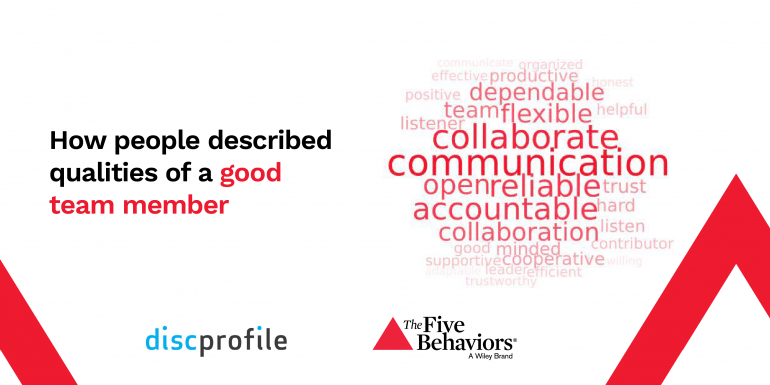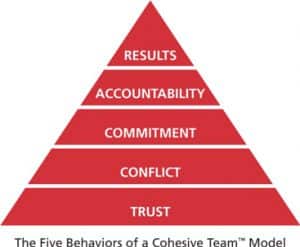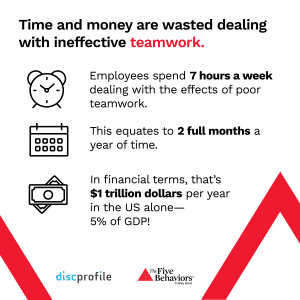You don’t have to be a human resources professional to know that where and how we work is changing for many people, especially for knowledge workers.
According to Nicholas Bloom, professor of economics, “Around 70 to 80% of firms are going to hybrid, the other 20 to 30% have mostly not decided. It looks like from the research, firms are going to be about 5% more productive doing that. And employees on average are significantly happier.”
However, moving to a hybrid work model will likely surface some new challenges, specifically around teams and teamwork. Teamwork skills can be learned and developed like any other skill. Leaders and managers need to place a special focus on addressing the teamwork skill gap to make hybrid offices successful.
Teamwork challenges of the hybrid office
In-groups
It’s difficult to build camaraderie when some people come in to the office and others work remotely. Colleagues might resent a coworker who isn’t available at the office. Or a remote team member might be left out of a conversation that’s taken into another room after a difficult meeting. Those who see each other in person can create their own in-group, forming relationships and holding information not available to the remote worker.
Uncertainties around pay and promotion
Should employees in the office get an extra stipend to reflect the cost of commuting and other expenses? Are in-office workers more likely to get promoted because managers observe them working every day? Even if leadership isn’t having these discussions, you can be sure employees are.
Networks
Mentorship, sponsorship, and networks are also of concern. Networks make moving from one team to another a more smooth transition and keep employees connected to leadership. “Ensuring equitable access in a hybrid environment cannot be emphasized enough,” said Tina Gilbert from Management Leadership for Tomorrow at a recent Future Forum event. Their survey found that “for every person who’s found it easier to find an executive sponsor while remote, 12 people have found it harder.”
These are all issues that leaders need to address and communicate to their employees. Workers need to know these basic conditions of work before they can move on to improving how their team works together with each other and with other teams.

Role of leaders and managers
Vision and mission
For teams to function well, they need to know what they are responsible for and how they will be held accountable. The year 2020 may have brought the organization’s mission into clearer focus or just the opposite. Leaders and managers need to be aligned around the organization’s mission and vision and communicate this to their teams.
Building culture
Even if all your staff return to the office, it’s doubtful that the culture won’t have experienced a significant change during the COVID-19 pandemic. As Bill Schaninger says in a McKinsey Talks Talent interview, “This is an unbelievable opportunity to remake culture. It’s rare in a leader’s lifetime to have such a clean drop for reshaping how you run the place.”
Creating a new or different kind of culture doesn’t require reinventing the wheel. What it does need is deliberate conversations and decisions around establishing new processes, policies, and actions. From encouraging trust to engaging in productive conflicts to rewarding teams rather than just individuals, culture is created.
As Pilar Orti, director of Virtual not Distant, states:
“It’s time to do what leaders of distributed teams and organisations do: they are explicit about their values, and deliberately integrate them into their operations: from recruitment, through onboarding, decision-making and communication. … We can continue talking about ‘building a strong culture,’ but it will be easier to build if you take time to reflect on the values that drive people’s decisions, and what behaviours—whether online or off, depending on where you’re heading—would help you achieve your aims.”
Building and rebuilding teams
As organizations make decisions about how and when to welcome or require workers to return to the office, we see one thing they might be forgetting: training workers on skills they need to be good team players. Collaboration among workers in a hybrid work environment makes these teamwork skills even more challenging and critically important.
It’s reasonable for managers and the C-suite to be concerned about worker productivity when coming in to the office is optional or they begin hiring a remote workforce, though they may be concerned for the wrong reasons. Productivity suffers greatly when communication and teamwork skills are lacking.
Unfortunately, teamwork is not a skill taught in most high schools or colleges, so often these skills need to be learned on the job. Nearly half of the students surveyed by College Pulse characterized their feelings about team-based class projects as either “somewhat negative” or “very negative.” Problems experienced in the classroom, such as unequal contribution, conflict, lack of accountability, confusion, and missing deadlines often occur in the workplace as well.
Wiley surveyed over 4,000 individuals between December 2020 and January 2021. Their results revealed a wide gap in teamwork skills plaguing virtual teams across the country. That gap—between the teamwork skills employees have and what they need in order to be effective—accounts for some of the key challenges they face. Most employees already know how to use email and messaging and participate in online discussions. What they don’t know is what will make them a great teammate and collaborator.
Technology and physical tools won’t solve the teamwork problem. Team members may be able to use communication tools without understanding how best to communicate with their collaborators.

Shared understanding of teamwork
Teamwork takes a commitment from each member of the team and a shared understanding of just what good teamwork is. There are models to help managers and team members with this. One of the most popular comes from Patrick Lencioni’s book The Five Dysfunctions of a Team.
“This is a time to really lean into being human,” Lencioni says. “This is not the time to save an hour or two in order to make people more efficient. This is the time to over-invest in time with one another as a team.”

Trust
As Lencioni’s team model demonstrates, trust among all team members is the foundation they must have to get results.
First, do managers trust their teams to do their work? Many leaders are discovering that people who understand their role and responsibilities will do their jobs, whether or not they’re in the manager’s line of sight. Next, the manager must consider how to build the team’s trust in them and in each other.
Accountability
Managers used to micromanaging or walking around to observe people working will need to select different ways of measuring the impact of a person’s work rather than measuring attendance. Team members want to know that they will be recognized for their work and still be able to ask another member for help.
Peer accountability is something teams of all kinds often struggle with, and hybrid or virtual workplaces likely make it even more complicated. Employees can’t quietly ask a teammate to step into the hall to confront them about talking over them in a meeting. They wonder how to share a challenge or even an accomplishment related to their individual tasks.
Shared ground rules can bring clarity around such things as when and how meetings will be scheduled or how and when conflicts will be addressed. Managers and workers who agree to hold each other accountable will do much better when issues inevitably come up.
There are many other elements that make up a cohesive team and contribute to a team’s success. The first step is for you and your team to embrace the mindset, backed by research, that teamwork is a collection of skills that can be taught rather than a vague, innate quality people either have or don’t.
Good teamwork requires ongoing practice. It’s easy for workers to get caught up in individual tasks and let interpersonal issues and conflicts ferment. Busy managers shy away from conflicts, provide unclear direction, or neglect to give feedback on team behaviors. If managers want results from their teams, they need to make sure team members understand what teamwork entails and how they can practice these skills. A tool like The Five Behaviors® Team Development assessment and training provides a path to follow.
Team charters
Another useful tool is the team charter. This should answer the question of why the team exists. It should make clear team roles, responsibilities, and resources. It should provide details on how team results will be measured and by whom.
A section on composition and roles should clarify what work or tasks the team members are committing to. A section for milestones, benchmarks, or deliverables will let everyone know how they will be judged as a team, if they are on a track toward success, and maybe when they can schedule small celebrations.
As reported in the Harvard Business Review, “today’s employees want to be measured on the value they deliver, not the volume. And they expect to be given the space and trust they need to do their very best work, wherever they happen to be.”
The section of the team charter that really covers issues around teamwork is the one for operations. Here teams can list their ground rules, their expectations for behaviors, communication requirements (platform, timing, tone, etc.), how they will make conflicts productive, and how they’ll hold each other accountable. Having all of this in print and accessible to all team members provides an anchor for team members, freelancers, those in-office, and those working from anywhere.
While someone in leadership will probably charge a team with a specific challenge, product, or activity, charters work best when the team works on the operations details of the charter together.
Many teams will benefit from the skills and outsider status of a facilitator when presented with the challenge of how to be a cohesive and high-achieving team. The real work of teamwork is personal and emotional and a little messy. That’s exactly why teamwork skills should be taught, discussed, and practiced. The payoff is happier, more productive employees and better results.


